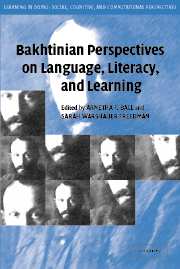Book contents
- Frontmatter
- Contents
- List of Contributors
- Acknowledgments
- PART I IDEOLOGIES IN DIALOGUE: THEORETICAL CONSIDERATIONS
- 1 Ideological Becoming: Bakhtinian Concepts to Guide the Study of Language, Literacy, and Learning
- 2 Dewey and Bakhtin in Dialogue: From Rosenblatt to a Pedagogy of Literature as Social, Aesthetic Practice
- 3 Intertextualities: Volosinov, Bakhtin, Literary Theory, and Literacy Studies
- 4 The Teaching of Academic Language to Minority Second Language Learners
- Voices in Dialogue – Dialoguing About Dialogism: Form and Content in a Bakhtinian Dialogue
- PART II VOICED, DOUBLE VOICED, AND MULTIVOICED DISCOURSES IN OUR SCHOOLS
- PART III HETEROGLOSSIA IN A CHANGING WORLD
- PART IV A CLOSING THOUGHT ON BAKHTINIAN PERSPECTIVES
- Author Index
- Subject Index
- Titles in the series
- References
3 - Intertextualities: Volosinov, Bakhtin, Literary Theory, and Literacy Studies
Published online by Cambridge University Press: 24 May 2010
- Frontmatter
- Contents
- List of Contributors
- Acknowledgments
- PART I IDEOLOGIES IN DIALOGUE: THEORETICAL CONSIDERATIONS
- 1 Ideological Becoming: Bakhtinian Concepts to Guide the Study of Language, Literacy, and Learning
- 2 Dewey and Bakhtin in Dialogue: From Rosenblatt to a Pedagogy of Literature as Social, Aesthetic Practice
- 3 Intertextualities: Volosinov, Bakhtin, Literary Theory, and Literacy Studies
- 4 The Teaching of Academic Language to Minority Second Language Learners
- Voices in Dialogue – Dialoguing About Dialogism: Form and Content in a Bakhtinian Dialogue
- PART II VOICED, DOUBLE VOICED, AND MULTIVOICED DISCOURSES IN OUR SCHOOLS
- PART III HETEROGLOSSIA IN A CHANGING WORLD
- PART IV A CLOSING THOUGHT ON BAKHTINIAN PERSPECTIVES
- Author Index
- Subject Index
- Titles in the series
- References
Summary
Intertextuality forms one of the crucial grounds for writing studies and writing practice. Texts do not appear in isolation, but in relation to other texts. We write in response to prior writing, and as writers we use the resources provided by prior writers. When we read we use knowledge and experience from texts we have read before to make sense of the new text, and as readers we notice the texts the writer invokes directly and indirectly. Our reading and writing are in dialogue with each other as we write in direct and indirect response to what we have read before, and we read in relation to the ideas we have articulated in our own writing.
Understanding how we use intertextuality as writers and readers can improve our practice as individuals and as collectives. Our writing can be more sure-footed as we notice the intertextual ground we stand on. We can become more deft and precise in invoking texts that we want the reader to see as relevant context and in excluding those intertexts that might distract the readers from the vision we want to present. As readers we can note more exactly those intertexts the writer is invoking, and how and for what purposes. Further, we can also decide as readers if we want to bring other texts to bear to the issue that the writer has not seen as relevant.
- Type
- Chapter
- Information
- Publisher: Cambridge University PressPrint publication year: 2004
References
- 20
- Cited by



